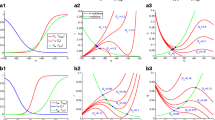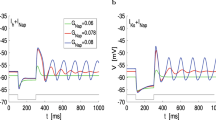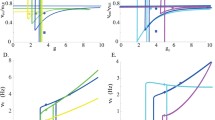Abstract
Phase response is a powerful concept in the analysis of both weakly and non-weakly perturbed oscillators such as regularly spiking neurons, and is applicable if the oscillator returns to its limit cycle trajectory between successive perturbations. When the latter condition is violated, a formal application of the phase return map may yield phase values outside of its definition domain; in particular, strong synaptic inhibition may result in negative values of phase. The effect of a second perturbation arriving close to the first one is undetermined in this case. However, here we show that for a Morris–Lecar model of a spiking cell with strong time scale separation, extending the phase response function definition domain to an additional negative value branch allows to retain the accuracy of the phase response approach in the face of such strong inhibitory coupling. We use the resulting extended phase response function to accurately describe the response of a Morris–Lecar oscillator to consecutive non-weak synaptic inputs. This method is particularly useful when analyzing the dynamics of three or more non-weakly coupled cells, whereby more than one synaptic perturbation arrives per oscillation cycle into each cell. The method of perturbation prediction based on the negative-phase extension of the phase response function may be applicable to other excitable cell models characterized by slow voltage dynamics at hyperpolarized potentials.







Similar content being viewed by others
References
Achuthan, S., & Canavier, C. C. (2009). Phase-resetting curves determine synchronization, phase locking, and clustering in networks of neural oscillators. Journal of Neuroscience, 29, 5218–5233.
Acker, C. D., Kopell, N., & White, J. A. (2003). Synchronization of strongly coupled excitatory neurons: Relating network behavior to biophysics. Journal of Computational Neuroscience, 15, 71–90.
Bressloff, P. C., & Coombes, S. (2000). Dynamics of strongly-coupled spiking neurons. Neural Computation, 12, 91–129.
Canavier, C. C., Butera, R. J., Dror, R. O., Baxter, D. A., Clark, J. W., & Byrne, J. H. (1997). Phase response characteristics of model neurons determine which patterns are expressed in a ring circuit model of gait generation. Biological Cybernetics, 77, 367–380.
Canavier, C. C., Baxter, D. A., Clark, J. W., & Byrne, J. H. (1999). Control of multistability in ring circuits of oscillators. Biological Cybernetics, 80, 87–102.
Canavier, C. C., Kazanci, F. G., & Prinz, A. A. (2009). Phase resetting curves allow for simple and accurate prediction of robust N.:1 phase locking for strongly coupled neural oscillators. Biophysical Journal, 97, 59–73.
Canavier, C. C., & Achuthan, S. (2010). Pulse-coupled oscillators and the phase resetting curve. Mathematical Biosciences, 226, 77–96.
Dror, R. O., Canavier, C. C., Butera, R. J., Clark, J. W., & Byrne, J. H. (1999). A mathematical critereon based on the phase response curves for stability in a ring of coupled oscillators. Biological Cybernetics, 80, 11–23.
Ermentrout, G. B. (1996). Type I. membranes, phase resetting curves, and synchrony. Neural Computation, 8, 979–1001.
Ermentrout, G. B., & Kopell, N. (1984). Frequency plateaus in a chain of weakly coupled oscillators. SIAM Journal on Mathematical Analysis, 15, 215–237.
Ermentrout, G. B., & Kopell, N. (1986). Parabolic bursting in an excitable system coupled with a slow oscillation. SIAM Journal on Mathematical Analysis, 46, 233–253.
Ermentrout, G. B., & Kopell, N. (1990). Oscillator death in systems of coupled neural oscillators. SIAM Journal on Mathematical Analysis, 50, 125–146.
Ermentrout, G. B., & Kopell, N. (1991). Multiple pulse interactions and averaging in systems of coupled neural oscillators. Journal of Mathematical Biology, 29, 195–217.
Golubitsky, M., Josic, K., & Shea-Brown, E. (2006). Winding numbers and average frequencies in phase oscillator networks. Journal of Nonlinear Science, 16, 201–231.
Guckenheimer, J. (1975). Isochrons and Phaseless Sets. Journal of Mathematical Biology, 1, 259–273.
Gutkin, B. S., Ermentrout, G. B., & Reyes, A. D. (2005). Phase-response curves give the responses of neurons to transient inputs. Journal of Neurophysiology, 94, 1623–1635.
Hansel, D., & Mato, G. (2003). Asynchronous states and the emergence of synchrony in large networks of interacting excitatory and inhibitory neurons. Neural Computation, 15, 1–56.
Hansel, D., Mato, G., & Meunier, C. (1995). Synchrony in excitatory neural networks. Neural Computation, 7, 307–337.
Izhikevich, E. M. (2006). Dynamics systems in neuroscience: The geometry of excitability and bursting (Chapter 10). Synchronization. Cambridge: MIT.
Izhikevich, E. M., & Kuramoto, Y. (2006). Weakly coupled oscillators (Vol. 5, p. 448). Elsevier: Encyclopedia of Mathematical Physics.
Kuramoto, Y. (1984). Chemical oscillations, waves, and turbulence. Berlin: Springer.
Latham, P. E., Richmond, B. J., Nelson, P. G., & Nirenberg, S. (2000). Intrinsic dynamics in neuronal networks. I. theory. Journal of Neurophysiology, 83, 808–827.
Maran, S. K., & Canavier, C. C. (2008). Using phase resetting to predict 1:1 and 2:2 locking in two neuron networks in which firing order is not always preserved. Journal of Computational Neuroscience, 24, 37–55.
Morris, C., & Lecar, H. (1981). Voltage oscillations in the barnacle giant muscle fiber. Biophysical Journal, 35, 193–213.
Netoff, T. I., Banks, M. I., Dorval, A. D., Acker, C. D., Haas, J. S., Kopell, N., et al. (2005). Synchronization in hybrid neuronal networks of the Hippocampal formation. Journal of Neurophysiology, 93, 1197–1208.
Oh, M., & Matveev, V. (2009). Loss of phase-locking in non-weakly coupled inhibitory networks of type-I. model neurons. Journal of Computational Neuroscience, 26(2), 303–320.
Oprisan, S. A., & Canavier, C. C. (2001). Stability analysis of rings of pulse-coupled oscillators: The effect of phase resetting in the second cycle after the pulse is important at synchrony and for long pulses. Journal of Differential Equations and Dynamical Systems, 9, 243–258.
Oprisan, S. A., Prinz, A. A., & Canavier, C. C. (2004). Phase resetting and phase locking in hybrid circuits of one model and one biological neuron. Biophysical Journal, 87, 2283–2298.
Pfeuty, B., Mato, G., Golomb, D., & Hansel, D. (2003). Electrical synapses and synchrony: The role of intrinsic currents. Journal of Neuroscience, 23, 6280–6294.
Rinzel, J., & Ermentrout, B. (1998). Analysis of neural excitability and oscillations. In C. Koch & I. Segev (Eds.). Methods in neuronal modeling: From ions to networks (2nd ed.). Cambridge: MIT.
van Vreeswijk, C., Abbott, L. F., & Ermentrout, B. (1994). When inhibition not excitation synchronizes neural firing. Journal of Computational Neuroscience, 1, 313–321.
Winfree, A. T. (1974). Patterns of phase compromise in biological cycles. Journal of Mathematical Biology, 1, 73–95.
Winfree, A. T. (2001). The geometry of biological time (2nd edn). New York: Springer.
Wang, X. J., & Buzsáki, G. (1996). Gamma oscillation by synaptic inhibition in a hippocampal interneuronal network model. Journal of Neuroscience, 16, 6402–6413.
Acknowledgement
This research was supported in part by the National Science Foundation grant DMS-0817703 (V.M.).
Author information
Authors and Affiliations
Corresponding author
Additional information
Action Editor: J. Rinzel
Rights and permissions
About this article
Cite this article
Oh, M., Matveev, V. Non-weak inhibition and phase resetting at negative values of phase in cells with fast-slow dynamics at hyperpolarized potentials. J Comput Neurosci 31, 31–42 (2011). https://doi.org/10.1007/s10827-010-0292-x
Received:
Revised:
Accepted:
Published:
Issue Date:
DOI: https://doi.org/10.1007/s10827-010-0292-x




